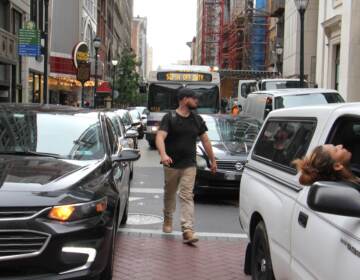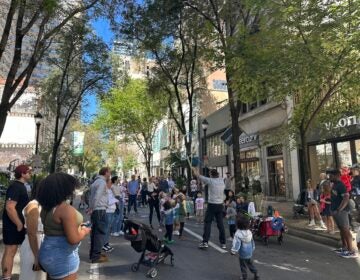It’s time to test a car-free Chestnut Street
Across the world, cities are taking their streets back from cars. Philadelphia has an opportunity to test the pedestrian-first model on Chestnut Street.

A large number of cyclists, runners, and pedestrians took the opportunity to ride, glide and walk over a car-free South Street during Philly Free Streets day in 2017. (Bastiaan Slabbers for WHYY)
Across the world, we’re seeing cities take their streets back from cars. Barcelona has it’s new superblocks, Madrid has piloted pedestrian-only streets, and even New York City has transformed the most famous intersection in the world, Times Square, into a plaza trafficked mostly by pedestrians.
Here in Philadelphia, we began to flirt with this idea after we banned cars in Center City while the Pope was in town back in 2015. People came out to walk, run, bike, and play in the streets at unprecedented levels. People saw that our streets can be more than a means for cars to get from one place to another — they could be a formerly off-limits public space, a destination upon themselves.
The “Pope Weekend” led to our annual Philly Free Streets, where a stretch of road is closed to cars and instantly becomes an urban oasis for pedestrians and cyclists. A part of Ben Franklin Parkway is used each summer for the wildly popular Oval pop-up park. The City also turns MLK Drive into a recreational path on summer weekends. Recently, there has been movement towards pedestrianizing popular shopping destinations such as Ninth Street through the Italian Market and Filbert Street next to the Reading Terminal Market. Projects such as these are great, but are usually either a one-off event or seasonal. They are primarily for recreation rather than mobility and a long-term public space.
The recent closure of the Chestnut Street Bridge for repairs, projected to last until next August, presents the perfect opportunity to prove that Chestnut street can survive and thrive without vehicular traffic. People often point to the former Chestnut Street Transitway to say that this would be bad for business. The Transitway occurred at a time when Philadelphia’s economy was in a nosedive, but the street’s configuration got the brunt of the blame.
Looking at Chestnut Street during rush hour you’ll see hundreds more people than cars traversing its narrow sidewalks and crossing its gridlocked intersections, all while carrying bags from local merchants. DVRPC pedestrian counts show over 1,000 people walk down Chestnut Street every day. In the last decade we have seen many vacant storefronts turn into eateries and boutiques. This is even more surprising considering recent trends towards online shopping.
The vehicle congestion on Chestnut Street is arguably the worst in Philly. Cars and buses moving at a snail’s pace for blocks, ride-hailing cars and delivery trucks stopping in the travel lanes. During most rush hours, it’s frankly faster to get out and walk.
A pilot of pedestrian-only hours on Chestnut Street from Broad Street to at least 24th street is an opportunity to demonstrate how beautiful such a street can be. Business can take over curb space with outdoor seating, pedestrians can walk on the street without fear of becoming roadkill, and sidewalks can be opened up for people to window shop without disrupting brisk walking pace of office workers commuting to their jobs.
Data has also shown a large increase in economic activity along corridors that eliminated automobile traffic. In 2018, Madrid’s car-free pilot area saw a 9.5% increase in retail sales over the Christmas season. Barcelona’s Superblock project has shown a 30% annual increase in businesses. Times Square’s pedestrian plaza has also seen enormous economic benefits for its neighborhood with a five-fold increase in retail rental prices.
In the age of online shopping, we need to recognize that people don’t want to just purchase items, but need a destination and an experience to get them out of their homes. But it’s not just about shopping.
A car-free Chestnut street can be augmented with more trees, public art, public seating, and programming that appeals to both our city’s families and growing younger population. The benefits to public health, air pollution, noise pollution, and public safety would also be immeasurable. Chestnut Street can become a true destination, resembling car-free areas in many major cities across the world.
Chestnut Street can be this place, only if we can make it happen.
WHYY is your source for fact-based, in-depth journalism and information. As a nonprofit organization, we rely on financial support from readers like you. Please give today.








